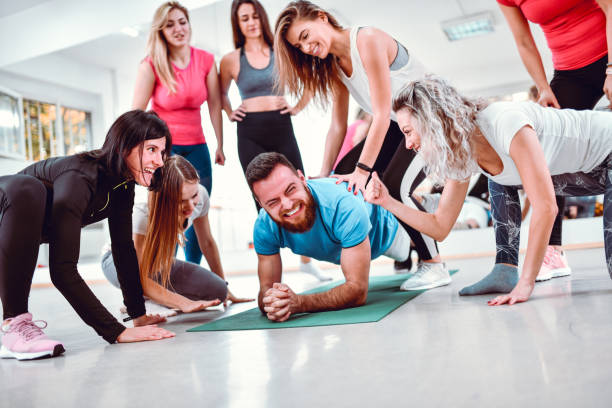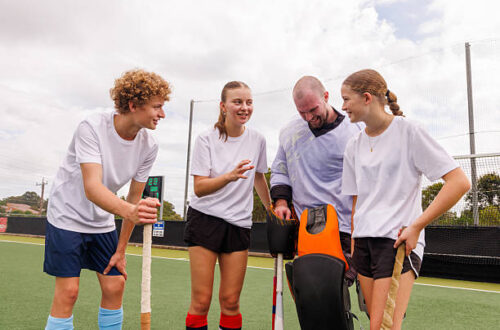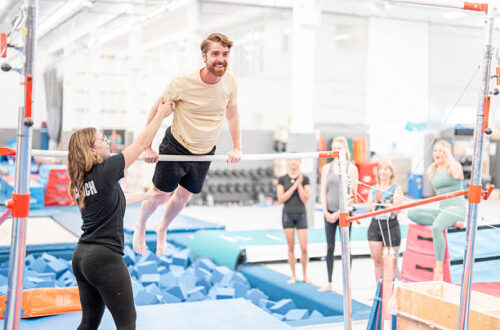Life as a student can feel pretty solo sometimes. You spend hours studying alone, writing papers by yourself, and working on projects for one. So when it comes to staying fit, why not make it a team effort? While solo workouts are great, exercising in a group offers a special kind of magic. It transforms a chore into a fun activity, a struggle into a shared victory, and a goal into a collective mission.
This blog post will explore the amazing benefits of group fitness and highlight some of the best activities for students to try. We’ll show you why working out with others isn’t just more effective, it’s also a powerful way to build community and make lasting friendships.
The Power of the Pack: Why Group Workouts Are Better
Contents
Working out with friends, a team, or in a class does more than just get you moving. It taps into key human motivators that make you more likely to stick with your fitness goals and push yourself harder.
Accountability and Motivation 📅
Have you ever hit the snooze button on your alarm, telling yourself you’ll just skip that morning workout? It’s a lot harder to do when you know a friend is waiting for you at the gym. When you commit to a group, you’re not just letting yourself down by skipping out; you’re letting others down, too. This external pressure—in a good way!—is a powerful tool for staying consistent. Studies show that people are far more likely to stick to a fitness plan when they have a partner or group to keep them accountable.
Friendly Competition and Fun 🏅
A little friendly competition can be a huge motivator. When you see your friends running a little faster or doing one more rep, it inspires you to push your own limits. This isn’t about being better than others; it’s about using the energy of the group to be the best version of yourself. Plus, when you’re laughing and cheering each other on, the hard work doesn’t feel so tough. It makes the time fly by and turns what could have been a boring workout into a fun, social event.
Building Community and Connection 🤗
One of the biggest struggles for students is feeling disconnected, especially in a large school or university. Group fitness is a fantastic way to meet new people who share your interests. You’re all there for the same reason, which makes it easy to strike up a conversation. Over time, these shared experiences—pushing through a tough workout or celebrating a personal best—can build strong bonds and lasting friendships. It gives you a sense of belonging and a support system that goes beyond the gym.
Social Support and Encouragement 🎉
Beyond accountability, there’s a powerful element of social support in group workouts. When you’re fighting to finish that last minute of a plank or a sprint, your teammates’ cheers can really help. Positive support from peers makes a safe space. Here, you can push your boundaries. It’s a great reminder that you’re not alone in your fitness journey. This shared struggle and shared triumph build a sense of camaraderie that is incredibly motivating.
Expert Guidance and Safety 🛡️
For students who are new to fitness, group classes offer a major advantage: a certified instructor. A good fitness instructor will not only lead the class but will also provide guidance on proper form and technique. This is a crucial benefit because it helps prevent injuries. Instead of trying to learn a new exercise from a video, you have a real person there to correct you, answer your questions, and offer modifications. This makes the workout experience safer and more effective, giving you the confidence to try new things.
Reducing Perceived Effort 🧘♀️
There’s a fascinating psychological phenomenon that happens in group workouts. The energy of the group can actually make the workout feel easier. When you’re surrounded by other people, your mind is often distracted from the physical discomfort. The music, the instructor’s cues, and the shared struggle make the time pass more quickly. What would have felt like a long, painful solo workout becomes a fun, engaging group experience.
Top Student Fitness Activities That Work Better in Groups
Now that you know the “why,” let’s get to the “what.” Here are some of the most effective and accessible group fitness activities for students. Many of these are low-cost, don’t require fancy equipment, and can be done right on campus.
1. Team Sports
This is the most classic form of group fitness for a reason. Team sports blend physical activity with strategy and communication. They also foster a strong sense of community.
- Why it works in a group: You can’t play a game of soccer or basketball alone! The whole activity is built around teamwork. You have a shared goal, which forces you to communicate, rely on each other, and celebrate wins together. The competitive and collaborative nature makes the workout feel less like exercise and more like pure fun.
- Student-friendly options: Look for intramural leagues or campus clubs in sports like soccer, basketball, volleyball, or ultimate frisbee. They are usually designed for all skill levels, from beginners to experienced players.
2. Group Fitness Classes 🤸♀️🧘♂️
Most university and college recreation centers offer a wide variety of group fitness classes, often for free or at a very low cost for students.
- Why it works in a group: A class is led by an instructor who provides expert guidance on form and technique, reducing your risk of injury. The music, energy, and shared effort of everyone in the room create a motivating atmosphere. It’s a great way to try something new without feeling intimidated.
- Student-friendly options:
- Zumba or Dance Fitness: High-energy classes that feel more like a party than a workout. They improve your cardiovascular health and coordination.
- Spin/Cycling: This is a high-energy cardio workout in a dark room with loud music. It’s great for pushing your limits and building strong leg endurance.
- Yoga or Pilates: Great for stress relief, flexibility, and building core strength with a supportive group.
3. Running or Walking Clubs 🏃♂️🚶♀️
You might thin running is a solo sport, but a club or group makes it a completely different experience.
- Why it works in a group: Having a running partner or a group provides a huge layer of accountability. On days when you don’t feel like going, knowing others are waiting can be the push you need. It also makes long runs feel shorter, and it’s safer to run in a group, especially at night. You can talk, listen to music, and cheer each other on.
- Student-friendly options: Look for a campus running club. Most have different pace groups, so you’ll always find someone to run with, no matter your speed.
4. Boot Camps and Circuit Training 🏋️♀️
These workouts involve a series of exercises performed in a circuit, often with a partner or small group.
- Why it works in a group: The structure of a boot camp or circuit training session encourages a supportive environment. You might be paired with a partner to do exercises, which builds trust and encourages you to motivate each other. The timer adds an element of urgency, and the shared struggle makes the victory of finishing that much sweeter.
- Student-friendly options: Many campus gyms offer free boot camp classes. You can also create your own with friends using no-equipment exercises like burpees, squats, and planks.
5. Hiking or Rock Climbing 🧗♀️⛰️
For students who prefer a workout with a side of adventure, these activities are perfect for groups.
- Why it works in a group: It’s safer and more enjoyable to hike or climb with others. You can explore new trails, take incredible photos, and have people to talk to on the way. Climbing with a partner is a necessity, as you rely on each other for safety and support. These activities build trust and create strong bonds through shared challenge and exploration.
- Look for outdoor adventure clubs on campus. They often plan group hikes and trips to local climbing gyms. These are great ways to get off campus and enjoy nature.
6. Martial Arts or Self-Defense Classes 🥋
Martial arts like Karate, Judo, and Brazilian Jiu-Jitsu are usually taught in groups. This makes them a great choice for group fitness.
- Why it works in a group: You learn through partner drills and sparring, which builds trust and communication. Going through different belt levels with your classmates builds a close community. These classes focus on more than just physical strength. They also help build discipline, focus, and confidence in a supportive group.
- Student-friendly options: Many campuses have martial arts clubs. You can also find affordable local studios that offer student discounts.
7. Dance Classes 💃
From hip-hop and salsa to ballroom dancing, dance is an incredibly fun way to get your cardio in while learning a new skill.
- Why it works in a group: Dance is a social activity by nature. You’re learning new moves and routines with others, which makes it a fun and low-pressure environment. It’s also a great way to improve your coordination, flexibility, and spatial awareness.
- Student-friendly options: Look for campus dance clubs or check local studios for beginner classes. You can often find free lessons or open dance nights.
Making It a Habit: Tips for Students on the Go
Finding the right group activity is the first step. The second is making it a regular part of your student life.
Find the Right Time ⏰
Do you have more energy in the morning or the evening? If you’re a morning person, a group run or an early yoga class can set a positive tone for your entire day. If you prefer to de-stress after classes, an evening team sport or dance class can be the perfect way to wind down.
Fueling Your Body 🍎
Group workouts often require more energy. Make sure you’re fueling your body properly. Have a light, carbohydrate-rich snack like a banana or a granola bar about an hour before your workout. Afterward, eat a combination of protein and carbs to help your muscles recover.
Beyond the Worout 🤗
Solidify the bonds with your new fitness group by hanging out outside of the workout. Grab a coffee after your run, or get dinner with your team after a game. This is where the true friendships are formed, making you even more likely to stick with your fitness routine.
Beyond the Workout: The Mental and Emotional Payoff
The benefits of group fitness extend far beyond a stronger body. In a world that can feel isolated and stressful, group workouts are a powerful antidote. They help combat the loneliness that many students feel by providing a sense of belonging and community. When you’re working toward a common goal with a group, you feel connected and supported. Sharing this experience can greatly cut anxiety and boost your mood.
It’s easy to get caught up in the pressures of academic life, but a group workout offers a much-needed mental break. It’s a chance to put your phone away, clear your head, and focus on the present moment. The positive energy and encouragement from a group can help you push through not only a physical challenge but also a stressful week of classes. Joining a group fitness class isn’t just good for your body; it also boosts your mental and emotional health. Both are key for a successful student experience.
Frequently Asked Questions
Q1: What if I’m a total beginner and feel intimidated?
Feeling intimidated is completely normal. The best way to overcome it is to start with a beginner-friendly sport or a casual, no-pressure team. Look for campus intramural leagues or club sports that are specifically designed for all skill levels. Remember that most people are just happy to have another person to play with.
Q2: How can I find groups if my campus is small?
If your campus doesn’t have a lot of options, look for groups in your local community. Look for running clubs, community sports leagues, or fitness studios that give student discounts. Social media groups can also be a great way to find like-minded people.
Q3: Are these activities okay for people with a disability or injury?
Yes. Many group fitness classes and sports can be modified. It’s always a good idea to speak with the instructor or coach beforehand to let them know about your specific needs. You can also look for adaptive sports leagues.
Q4: Do I need to be in great shape to join?
Not at all. Everyone starts somewhere. These groups are about getting fit and having fun, not about being a pro. You’ll improve your fitness over time just by showing up and participating.
Q5: How do I balance group workouts with a busy academic schedule?
Treat your group workout like an important class and schedule it in your planner. Having a fixed time and a group of people waiting for you makes it harder to skip.
Q6: What about the cost? I’m on a tight student budget.
The great news is many group activities are free! Campus recreation centers often offer free group fitness classes or have equipment you can borrow. Campus running clubs and intramural sports are usually low-cost. Look for community groups that meet at parks or trails, which are always free.
Q7: What if I’m shy or introverted?
You don’t have to be a social butterfly to enjoy group fitness. A walking club or a quiet yoga class can be a great, low-pressure way to start. You can simply show up, do your workout, and then ease into the social aspect at your own pace. The shared effort and positive energy of the group are still there, even if you don’t feel like talking much.
Q8: How do I know if the group is right for me?
Try it out! Most classes or teams allow you to join for a single session without a long-term commitment. This “test drive” will help you figure out if the group’s vibe, energy, and pace are a good fit for you.





